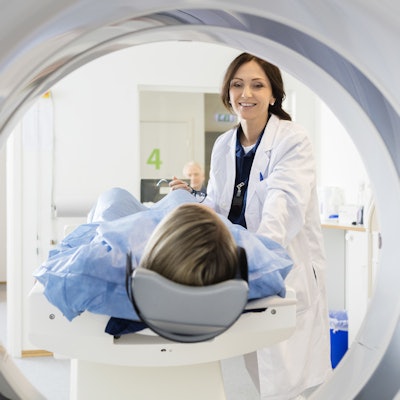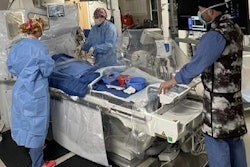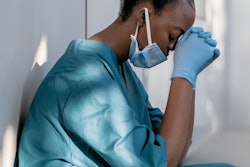
One of the most effective tools for managing COVID-19 is chest CT. But how do you keep radiologic technologists (RTs) safe while scanning potentially infected patients? A group from China shared its recommendations in an article published April 20 in the European Journal of Radiology.
The group from a hospital in Wuhan, where the SARS-CoV-2 virus first appeared, is offering colleagues a list of actions to keep radiographers healthy as they scan potentially infected or infected patients.
"It is critical for the radiology department to ensure the personal safety of radiologic technologists and avoid cross-infection," wrote the authors, led by Dr. Yanjie Zhao of Tongji Hospital. "In this review article, we describe the systematic strategies to combat COVID-19 from the radiology department in Tongji Hospital in ... China, including personnel arrangements, environmental modification, protection levels and configurations, radiological imaging (CT and radiography), and disinfection methods."
The authors listed the following ways to help technologists avoid SARS-CoV-2 infection:
- Monitor radiographers' health. Conduct personal health monitoring and reporting (occupational exposure to COVID-19 or disease symptoms). If exposure is suspected or symptoms are present, technologists should undergo blood testing, CT imaging, and reverse transcription polymerase chain reaction (RT-PCR) testing.
- Set schedules. Tongji Hospital's radiology department divided 18 radiographers into three teams that would be responsible for chest CT and mobile x-ray (four on CT and two on x-ray). Each member of the team works for up to six hours per day and then is off for 24 hours (i.e., a team member works from 6 a.m. to 12 p.m., then reports the next day to work from 12 p.m. to 6 p.m.). "This kind of schedule not only avoids long exposure to the virus, but also ensures adequate rest for the radiologic technologists," the group wrote.
- Modify the environment. The hospital set up a dedicated CT scanner for infected patients, as well as a pathway for patients from the waiting area to the scanner that included a "contaminated" area, a "potentially contaminated" area, and a "clean" area. It also set up a pathway for radiographers to travel from clean areas to contaminated areas and back.
- Provide appropriate personal protective equipment (PPE), and ensure radiographers put it on and remove it in the correct order. Radiographers performing CT scans wear caps, surgical masks, respirators, protective glass, isolation gowns, shoe covers, and disposable gowns; those performing mobile digital x-ray wear this gear plus a face shield.
- Disinfect scanning areas. Turn off central air conditioners and use an air purifier in the CT control room. Contaminated and potentially contaminated areas have ultraviolet lamps that are used for an hour two to three times daily. CT room surfaces are wiped with bleach solution, while the scanner is cleaned with 75% ethanol solution.
Zhao and colleagues hope their review will help colleagues safely combat the virus and keep staff safe.
"[The article] can provide guidance to other radiology departments faced with COVID-19 to reduce infection risk for radiologic technologists," they wrote.





















